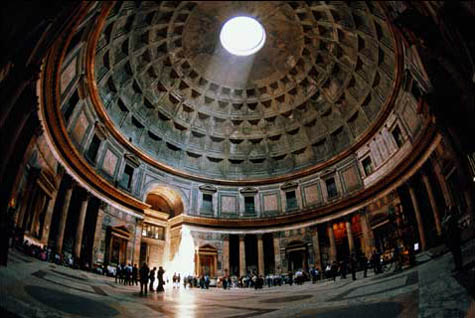At www.bldgblog.com/2007/04/the-heliocentric-pantheon-an-interview-with-wal… … this pieces was sent in by Brian, a long time SIS member. He is hoping to open discussion with other members of the society – and presumably with anyone not in the society but who have a genuine interest in the subject matter of the post. This revolves around the Pantheon – built in the reign of Roman emperor Hadrian. We know about the wall he had built between Britannia and Caledonia but the Pantheon has to be the biggest dome built (at the time), 142 feet in diameter. It remains standing today which must be a testament of Roman expertise. It has survived for another reason and that is that it was consecrated in 609, a pagan temple that became a Christian church (dedicated to St Mary and All Martyres). Dio Cassius mentions it saying the Pantheon was Greek for All Gods (hence, I suppose, all martyrs). However, Dio Cassius preferred another origin of the name as in the interior of the dome a vaulted roof resembles the heavens ….
 … there is a hole in the top of the dome which lets in the light, thought to symbolise the Sun. It is surrounded by a series of concentric circles possibly representing the orbit of the planets around the Sun. We are then introduced to Copernicus. He visited the Pantheon and the author of the piece wonders if he was influenced by the interior of the dome and thence came up with the idea the earth orbits the Sun and the moon orbits the earth. The article progresses on to Bode's Law and the rotations (and their ratios) that underlie the orbits of the planets and the moons around the planets. Bode's Law gives a series of orbital ratios which are mathematically identical to intervals in musical theory.
… there is a hole in the top of the dome which lets in the light, thought to symbolise the Sun. It is surrounded by a series of concentric circles possibly representing the orbit of the planets around the Sun. We are then introduced to Copernicus. He visited the Pantheon and the author of the piece wonders if he was influenced by the interior of the dome and thence came up with the idea the earth orbits the Sun and the moon orbits the earth. The article progresses on to Bode's Law and the rotations (and their ratios) that underlie the orbits of the planets and the moons around the planets. Bode's Law gives a series of orbital ratios which are mathematically identical to intervals in musical theory.
The article is actually an interview with Walter Murch, winner of three Academy awards and film editor and sound designer (where music plays a role). Is there anything in this as Bode's Law is not currently in favour.
